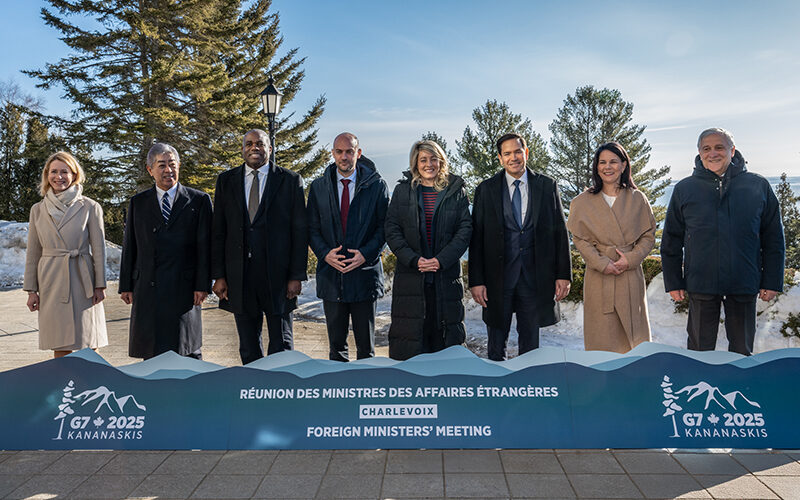Kananaskis, Alberta (Rajeev Sharma): World leaders have begun arriving in the scenic mountain town of Kananaskis, Alberta, for a high-stakes Group of Seven (G7) summit, with a backdrop of international conflict, economic uncertainty, and rising tensions with the United States casting a long shadow over proceedings.
The G7, comprising Canada, the United States, France, Britain, Germany, Italy, and Japan, will be joined by the European Union and a select group of invited heads of state. Canadian Prime Minister Mark Carney, who is hosting the summit, has extended invitations to several global partners, including India, South Korea, Mexico, Brazil, South Africa, Australia, the UAE, and Ukraine.
Ukrainian President Volodymyr Zelenskyy is among the first to arrive and is scheduled for a closely watched meeting with U.S. President Donald Trump. The two leaders last met in a tense Oval Office encounter earlier this year that exposed the volatility of U.S. foreign policy under Trump.
Trump’s presence at the summit, as in previous years, is both pivotal and precarious. Bilateral talks with the U.S. president are often seen as unpredictable, with world leaders attempting to strike a delicate balance between engaging with Trump and countering his increasingly transactional worldview.
Mexican President Claudia Sheinbaum, attending her first G7 summit, said she expects her first in-person meeting with Trump, a moment many observers will watch closely given past tensions over trade and immigration policies.
The summit also marks the debut of several newly elected leaders on the world stage, including German Chancellor Friedrich Merz, British Prime Minister Keir Starmer, and Japanese Prime Minister Shigeru Ishiba, all of whom are navigating new foreign policy challenges and looking to reshape alliances strained by recent global upheavals.
A Decline in U.S. Influence?
In a sign of mounting frustration within the G7 over the shifting U.S. role in global leadership, Canadian Prime Minister Mark Carney delivered a bold assessment earlier this week, stating that America is no longer the “predominant” force in the international order.
“We stood shoulder to shoulder with the Americans throughout the Cold War and in the decades that followed,” Carney said. “Today, that predominance is a thing of the past.”
He criticized what he described as President Trump’s “monetization of hegemony,” referencing tariffs on allies and reduced U.S. contributions to collective security. Carney’s remarks, delivered in French, underscored a growing rift between Washington and its traditional allies over economic and security priorities.
French President Emmanuel Macron also made a symbolic move ahead of the summit, stopping in Greenland en route to Canada in a show of European unity, and, some suggest, subtle defiance of Trump’s past statements about acquiring the Arctic territory.
Tensions in the Middle East and Ukraine on the Agenda
The summit comes amid escalating violence in West Asia, with Israel’s recent attacks on Iran and Iran’s response threatening to spiral into wider regional conflict. The situation is expected to dominate much of the summit’s agenda, with leaders seeking a coordinated diplomatic response to prevent further escalation.
Meanwhile, the war in Ukraine remains unresolved. Zelenskyy’s participation signals a continued push for international support, though Trump’s stance on Ukraine, including past hesitancy on security guarantees, has left European leaders cautious.
Italian Prime Minister Giorgia Meloni has positioned herself as a bridge between Trump and Europe. While she maintains strong support for Ukraine, her efforts to maintain cordial relations with Washington amid threats of tariffs on European goods have proven politically complex.
A Fragile Unity
While the summit offers opportunities for dialogue, unity remains fragile. With Trump’s nationalist approach clashing with more multilateral visions embraced by other G7 members, the summit risks becoming a series of bilateral maneuverings rather than a collective demonstration of strength.
Still, leaders are expected to push forward on climate initiatives, trade cooperation, and global security discussions — even if, as one Canadian official noted, “Trump’s presence will test everyone’s patience and diplomacy.”
As the summit gets underway in the Canadian Rockies, the stakes are high — not just for the leaders present, but for the global order they are trying to stabilize. Whether this year’s G7 will yield substantive outcomes or simply underscore existing fractures remains to be seen.

